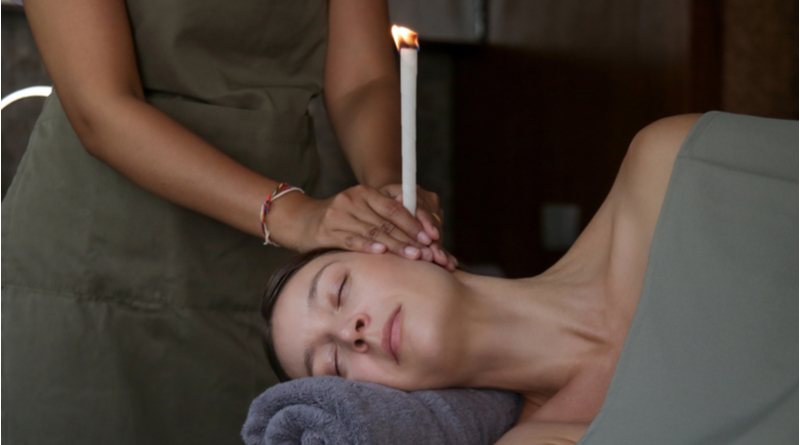What are Ear Candles and Thermal Auricular Therapy?
Thermo-Auricular therapy or ear candling is a non-invasive therapy designed to stimulate healing and well-being on a spiritual level. Traditionally ear candles were suggested to be used for earache, excess earwax, blocked sinuses, headaches, ear noise such as tinnitus, and everyday stresses and nervousness.
One end of the ear candle is inserted gently into the opening of the ear canal whilst the other end is lit. This produces a slight suction; whilst the movement of the flame creates a vibration of air in the candle to generate a massage-like effect on the ear-drum.
What 3rd level courses are available?
Universities and colleges in Ireland are offering Ear Candles Courses / Thermal Auricular Therapy courses in the following subject areas:
- Ear Candles Course / Thermal Auricular Therapy – Gain the necessary practical and theoretical skills to provide Thermal Auricular treatments to the general public and to gain employment in the Beauty/Holistic and Spa industry.
Studying Ear Candles Courses / Thermal Auricular Therapy courses in college
There are many courses in Auricular Therapy that take place over 1 year to 4 years depending on the course and modules selected. There are also part-time courses and night courses available so you can be sure to fit in your studies no matter what your schedule is like.
Courses will cover theory work through lectures, assignments, tutorials, and taught modules. Assessments will take place continuously with written examinations and practical assignments combined to achieve a qualification.
You could also consider work experience or a work shadow in the industry. Gaining work experience in a role supporting people from diverse backgrounds on a one-to-one basis would be helpful. Any work which involves listening to people, assessing needs, and helping others to plan actions is a good basis. Demonstrating an active interest in using alternative medicine and the use of natural remedies would also be an advantage
By job shadowing and carrying out work experience assisting a professional in the field you’ll gain valuable insight, develop your client base, build a network of contacts and demonstrate your commitment to the profession. Observation is one of the best ways to learn skills and techniques.
Career options
After completing an Auricular course you will be able to get started in a career that uses specific knowledge of ear and skin treatments and techniques.
Most professions within the beauty and alternative medicine fields will normally work from consulting and treatment rooms that may be at your home or an alternative therapy/wellbeing center or a natural health shop. You may also visit people in their own homes.
In the first few years after qualifying, you’re likely to be mostly building your business and clientele. You may find that you adapt and adjust your business and practice as you gain experience and start to recognize themes of need from clients and your local community.
You might start to identify specialist areas, build partnerships and establish strong referral routes. As you become established you may look for opportunities to develop your professional practice and expertise through further training.
Working hours will depend on whether you are employed by a company with set business hours or if you are contracted to various facilities or companies. Hours are usually full time but you may have to offer evening and weekend appointments to meet client needs. Follow-up and continued support of clients are likely to involve answering phone calls and emails, which may be outside of regular working hours.
Related jobs include:
- Naturopath
- Herbalist
- Massage therapist
- Beauty therapist
- Beauty technician
- Chiropractor
- Yoga instructor
- Reiki practitioner
- Acupuncturist
- Tai Chi or Qigong Instructor
- Biofeedback practitioner
- Holistic skincare specialist
Further study
After completing Ear Candles Courses / Thermal Auricular Therapy courses you may choose to pursue further study in a specialist field to increase your knowledge base and skillset. Postgraduate study can also be used as a means to change career focus or to gain professional qualifications required to practise in certain career areas such as acupuncture, homeopathy, naturopathy or herbal medicine.
FAQ
What comes out of your ear after ear candling?
At the end of ear candling, all that is left are the candle stub and a dark substance that is ear wax. Medically known as “cerumen,” ear wax is a naturally occurring substance that serves to clean, protect and lubricate the ear canal.
What are ear candles typically used for?
People use ear candles to remove wax, improve hearing, and cure ear infections. It’s also touted as a way to treat:
- sinus infection
- headache
- swimmer’s ear
- cold
- flu
- sore throat
- Other people claim that it helps to control blood pressure and stress.
What skills could be helpful for a career in Ear Candles Courses / Thermal Auricular Therapy courses?
As with any profession where you are working with clients, it is best to have a warm and friendly approach so that you can build a rapport with clients and put them at ease. You should have confidence talking to people of all ages from a wide range of backgrounds and excellent listening skills to effectively gain client history and check personal facts.
A diplomatic, patient and non-judgmental approach and a passion for the natural approach to health and wellbeing will be beneficial also.
Where can I study Ear Candles Courses / Thermal Auricular Therapy courses?
Explore your options here
Did You Know?
- Our amazing ears never sleep, even when we do. Human ears don’t cease to function when we are asleep. In fact, they still can pick up sound. It’s your brain that is allowing you to sleep since it is blocking out the sounds so you can get a good night’s rest.
- Did you know that the skin inside your ear continuously grows and renews itself through constant shedding? In fact, the skin of your ear canal grows an average of 1.3 inches per year!
- The human ear can come in many sizes and shapes. According to a study published in the journal Plastic and Reconstructive Surgery, men’s ears are typically larger than women’s, with the average ear measuring about 2.5 inches long.
- Our ears do more than just permitting us the gift of hearing. Our ears also help facilitate balance. Within the ear, there are three main parts: the inner ear, middle ear, and the external ear. The vestibular complex in the inner ear and the Eustachian tube in the middle ear help give us a sense of equilibrium and balance.
- Your ability to hear is dependent upon the tiny hairs that reside inside your ear. Inside the cochlea, there are thousands of these tiny hair cells that can change sound vibrations into electrical signals that are sent to the brain. So essentially, if you lose the hairs in your ears, you will lose your ability to hear.












Comments